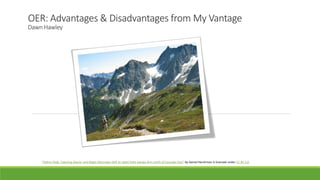Hawley benefits challenges of oer
- 1. OER: Advantages & Disadvantages from My Vantage Dawn Hawley "Pelton Peak, Yawning Glacier and Magic Mountain (left to right) from Sahale Arm north of Cascade Pass" by Daniel Hershman is licensed under CC BY 2.0
- 3. 1. Save students money "Save Money" by 401kcalculator.org is licensed under CC BY-SA 4.0 OER can save students money if we switch to open textbooks and other open learning materials from expensive traditional texts and materials.
- 4. 2. Easier to update & keep information current "Film editing table" by Marcel Oosterwijk is licensed under CC BY-SA 2.0 OER resources are easier and quicker to update as information changes than are traditional learning materials.
- 5. 3. Social good ŌĆō expand access, equity Open door to Burgundy vineyards" by My Wave Pictures is licensed under CC BY-NC-ND 2.0 OER provide access to information and learning for people from all walks of life and all positions on the socioeconomic spectrum.
- 6. 4. Contribute to worldŌĆÖs knowledge ŌĆō educator and students engagement "Graphic from the licensing tutorial" by Wikimedia Foundation is licensed under CC BY-SA 3.0 OER make it possible for all people to contribute meaningfully to the creation and sharing of the worldŌĆÖs knowledge.
- 7. 5. Freedom from commercial influence (academic/intellectual) "A mobile coop for free range laying hens on the farm" by Jessica Reeder is licensed under CC BY-SA 2.0 OER are more likely to be free from commercial and marketing influence and constraint.
- 8. Disadvantages to using OER
- 9. 1. Quality of information "(Another) One of these Things is not like the others." by JD Hancock is licensed under CC BY 2.0 Not all OER are the same. There are issues of content consistency and quality.
- 10. 2. Quantity of resources "Desert" is in the Public Domain, CC0 Suitable resources are scarce in some subject areas.
- 11. 3. Compensation for research work & time "An American Builder" by Palmer, Alfred T. is in the Public Domain ShouldnŌĆÖt people be compensated for their hard work?
- 12. 4. Consistency of curriculum/educational experience Can OER negatively impact the consistency of the curriculum and learning opportunities from student to student? Are all students getting what they pay for?
- 13. 5. Sustainability of OER repositories and collections ŌĆō who maintains them? "Great Pyrenees Sheep Dog Guarding the Flock" by Don DeBold is licensed under CC BY 2.0 WhoŌĆÖs going to watch over and maintain collections of free and open materials? How and by whom will these caretakers be compensated?
- 14. ItŌĆÖs an interesting and challenging journey. CanŌĆÖt wait to see where it leads us. Presentation available under Creative Commons Attribution-NonCommercial 4.0 International License. "Scenic route" by fede. cerutti is licensed under CC BY 2.0













